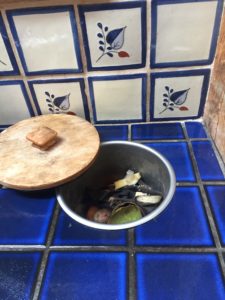Living in a rural area outside Santa Fe, we are masters of our own waste, free of pesky rules concerning style and content of compost facilities. Our “facility” is about the size of a small bedroom or a large closet, contained within four walls of straw bales, stacked two bales high. It is divided into two cells, one where the fresh offerings go, and the other where the compost is left for the final conversion to soil. I know there are those with other systems, plastic barrels that you roll on the ground to activate whatever the composting agents are, and plastic bins that sit in a frame and you turn with a crank. They adhere to strict rules about what goes into the bin – only fresh vegetables. — but the result can be disappointing, smelly and slimy.

We, on the other hand, are equal opportunity composters. There is nothing in the animal or vegetable kingdom that is not welcome. Our compost bucket takes all vegetable matter (the older the better), as well as chicken carcasses, fish bones, paper towels, egg cartons, stale crackers, sour milk, old wine, and leftovers whose identity is masked by a thick layer of blue, green or gray fuzz. Egg shells and coffee grounds are treasured.


Roberto dumps the bucket a couple of times a week, and every month or so sprinkles a thin layer of moldy leaves or horse manure on top. He built a wire mesh frame for the top to keep out the larger mammals and the birds who would eat all the worms who of course are our workforce. Mice come and go through the hay bales, trying new menu items and generally churning things up. These workers, and billions of microbes, labor through the seasons and in the spring we are blessed with beautiful black soil, like magic.
There is something deeply satisfying about composting. If we have forgotten a bag of kale in the back of the refrigerator drawer, or those tangerines in the basket on the kitchen table have gone soft, my first thought of course is food-waste-guilt. But this is quickly overtaken by “Oh, the compost will love this!” Nothing is wasted. The kale, the tangerines will soon join a world of decomposing matter in our back yard, and in the spring their cells will be rearranged into that rich, dark soil which will nourish our trees and garden.
I am comforted by this thought. Yesterday we hauled half-empty wine bottles out back and shared a couple of gallons of merlot and pinot grigio with our compost workers. It was a farewell toast to 2018, a stressful year in so many ways.
May 2019 be a year that nourishes – our planet, our children, our compassion for one another. And if not…there’s always the compost.


Myfeelings about compost exactly. Thanksfor putting it into words so elegantly..
Happy 2019. Let’s hope it’s a saner year!
Thanks, Zenia, and warmest 2019 wishes to you for a rich and nourishing year…in the compost, at least!
Thanks, Lucy. This is a good thought for the new year. We love our compost setup which is just like yours. So do our worms! Happy New Year to you!
Let’s keep those worms happy in 2019!
Wine for your composting worms! What a great start for their 2019!
Wishing you a fabulous 2019!
Gotta treat your workers well!
Love love love this Lucy – here’s to a beautiful 2019 rich with human kindness and other things that nourish the world.
Thanks,Susan. You’re one of the most nurturing people I know!
this inspires me to do more than an occasional coffee grounds on the roses, when I think about it. what kind of bucket do you use? I left all the leaves all over the yard this year, and didn’t cut the grasses. (except in the back yard because my long haired cat got stick ticks in his ears). good news, the birdseed sprouted, but that was the time that we had to weedwhack. thanks for the tips. better than clogging up my garbage disposal by putting leftovers down. (I had to call the plumber!) yet another reason to compost. thanks, love, LInda
Glad you’re inspired. Our bucket is a stainless steel canister (commercial kitchen style,about 10 inches in diameter, with a lip around the top). Roberto made a hole in the counter top to drop the canister in and a stylish wooden lid to cover it. We just lift the lid and drop whatever in. When it’s full, out it goes to the eagerly awaiting compost dwellers.
If I might add an idea: I use a juice pitcher with a lid, and keep the compost in the fridge. I don’t have the counter space for a compost bucket there. Keeping it in the fridge means no smell, even in summer. I can take it out to my pile when it’s full and I’m ready. The handle on the juice pitcher makes it easy to carry – sometimes important when carrying potentially messy things. (I do have fridge space – which I’m sure is not the case for everyone.) . . . . My compost pile itself is also rather, ahem, informal.
Great idea, Sharon. Just FYI, I have added a photo to the post of our compost bucket, by popular demand.
This is exactly my method for composting – everything and even old cotton rags, or old pieces of wool. I love this post – and encourage us all, if we can, to try it. I’ve been at it for over 25 years! Thank you Lucy –
Thank you, Dyanna. Wonderful to hear from you and know that there are like-minded composters out there!